Berlin , the capital of Germany , is a city established on both banks of the Spree River, which runs through the middle of the city. Although it is known for the Berlin Wall that divides the city into East and West Berlin from the second half of the 20th century until 1990, today it is an elegant metropolis with its naturalness, tolerance, energy and dynamism embracing different cultures. The beautiful parks and beautiful gardens stretching for miles in the middle of the city show that Berlin will never get old.
Berlin combines evidence of its centuries-old history as a settlement with fine details from 20th century history. Its architecture also reveals the city’s story about the past with its magnificent Prussian palaces, cold buildings of the Hitler era, symbolic monuments of the days of the Holocaust, and wall ruins and museums reminiscent of the Cold War years.

Berlin, the largest city in Germany in terms of population, draws a different Germany silhouette with its attractive venues that maintain its unique rhythm, where many theaters and cinemas are overflowing with young population under 35, lively cafes and bars are spread all over the city.
Berlin Travel Guide
While Berlin was a fishing village, from the 18th century onwards, with the strengthening of Prussia, it became one of the most important political, economic and cultural centers of Northern Germany and then of Europe.
II. According to 2008 data, 3.5 million people live in Berlin, where 4.3 million people lived before World War II. Berlin is located in northern Germany, in the sandy area between the rivers Spree and Havel. The Berlin Wall (Wall of Shame), which separated East and West Berlin from 1961 to 1990, was later removed and East Germany and West Germany united and renamed Federal Germany.
After the fall of the Berlin Wall, the cultural and creative energy of the city immediately began to rise. Today, it is one of the impressive cities of Europe with its cheerful, lively and somewhat radical atmosphere. Both artistic and cultural projects and architectural designs are changing so fast that they reveal the spirit of an ever-changing city and an unconventional lifestyle.
Berlin, which has gone through a lot of architectural and urbanization processes by becoming the capital of the German Empire and Nazi Germany, is completely unique in its stance in today’s Europe.
Combining the remnants of its deep-rooted history with the twentieth century line and carrying its country to the future with creativity, harmony and tolerance, Berlin is one of the most modern capitals of today’s Europe with its different cultures, dynamism, historical textures, museums and art galleries. Berlin is also internationally known as the cultural capital of Europe in the fields of architecture, fine arts and performing arts.
Berlin is a very green metropolis. Almost one-fifth of this city area consists of forests, but also has a nature surrounded by a maze of rivers and lakes. Tiergarten, Grunewald and Spandauer Forst districts are the largest nearby recreation areas of Berlin.
The official currency of Germany is the Euro. The official language of Germany is German. Berliners speak German with a slight accent. English is more known to those living in the west of the city. The electrical voltage is 220-250 Volts. You do not need to take an adapter with you, as the usual two-hole sockets are used.

Berlin Places to Visit
Berlin Architectural Route : It is almost a paradise for those who are closely interested in Berlin’s architecture. The buildings, where modern architecture and historical lines are intertwined, draw a framework that is as bold as it is simple, and monumental as well as majestic. When combined with wide squares and lush parks, a very characteristic city emerges.
One of the best architectural experiments in Berlin, the Reichstag in Tiergarten, the Berlin Cathedral rising from the banks of the River Spree, the most striking example of 21st century modern architecture, PostDamer Platz, the Branderburger Gate, Alexanderplatz, Friedrichstrasse, the TV Tower and the Funktrum.
Art Route : Berlin, whose artistic and architectural aspects complement each other, is the leader of Europe in the art scene with around 440 galleries and around 3000 exhibitions. The East Side Gallery of the Berlin Wall, painted by many artists, the art galleries in Mitte, Savignyplatz, Auguststraße, Tiergarten Potsdamer Strasse, the magnificent Charlottenburg Palace, which is one of the most vivid examples of Baroque art, and Potsdam, which has the most magnificent examples of Prussian art, is the aristocratic architecture and art of Berlin. to see the correct addresses.
Bellevue Palace, which stands out as the first neoclassical building in Germany, and the Museum of Contemporary Art, Maxim Gorki, Deutsches, Berliner Ensemble Theaters, and Deutsche and Komische Operas are important art centers in the city that should be visited.
Bauhaus Museum fur Gestaltung (Tiergartan), Deutsche Guggenheim Berlin (Mitte), Deutsches Technikmuseum (Kreuzberg), Gemäldegalerie Museum (Tiergarten), Jüdisches Museum (the largest Jewish museum in Europe-Kreuzberg), Pergamon Museum (Mitte), Reichstag are a must-visit places you should go.
Green Berlin Route : A feature that distinguishes Berlin from other European metropolitan cities. Especially the city’s lung, Tiergarten, river tours on the Grünewald, Spree and Havel Rivers in the southwest, cycling and sunbathing in Wannsee and Mügelsee, and witnessing tropical plant varieties in the Botanical Garden are among the things to do in this city.
On the other hand, Berlin, with its wide squares and lush city center, does not hesitate to offer stops that will take a breather in the busy city life. Berlin Zoo is one of the most beautiful city zoos in the world.
It is necessary to spare at least 3 days to visit Berlin, which is on the UNESCO Creative Cities list, with its squares, museums, historical textures and green areas. Especially if you are planning to visit museums , I recommend you to buy a Berlin Pass .

Branderburg Gate (Brandenburg Gate) is one of the most important symbols of the capital as one of the rare structures that managed to survive in Berlin. The building, which has witnessed the last two centuries of the city’s history since 1791, was built by the II. Although it was destroyed in World War II, it was the symbol of the city’s division. Unlike the Reichstag, which remained in West Berlin throughout the cold war, it was on East Berlin territory.
After the fall of the Berlin Wall in 1989, it became a symbol of peace, freedom and unity. Brandenburg Gate, to the north of which is the Reichstag, is located on Pariser Platz, which is home to the city’s important buildings. There is a Quadriga Sculpture facing east on the door, which has a dozen columns, six on each side. Hotel Adlon and Akademie der Künste (Art Academy), which are among the places to visit in Berlin, are also located here.
2nd Reichstag
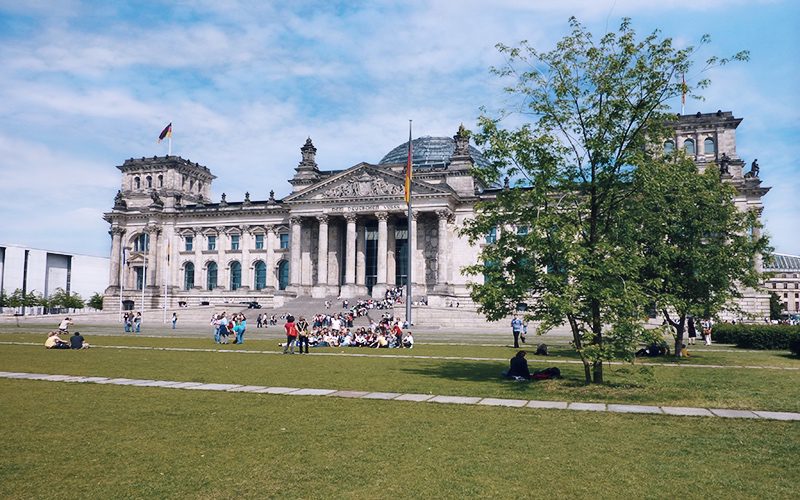
From the glass dome at the top of the Reichstag (Parliament Building), you can watch the city’s activity and the daily hustle and bustle of Berliners from a bird’s eye view. Likewise, you have the opportunity to see structures such as the Bundeskanzleramt (Federal Chancellery) and Brandenburg Gate, which are a series of public buildings around the Reichstag.
3. Potsdam Square
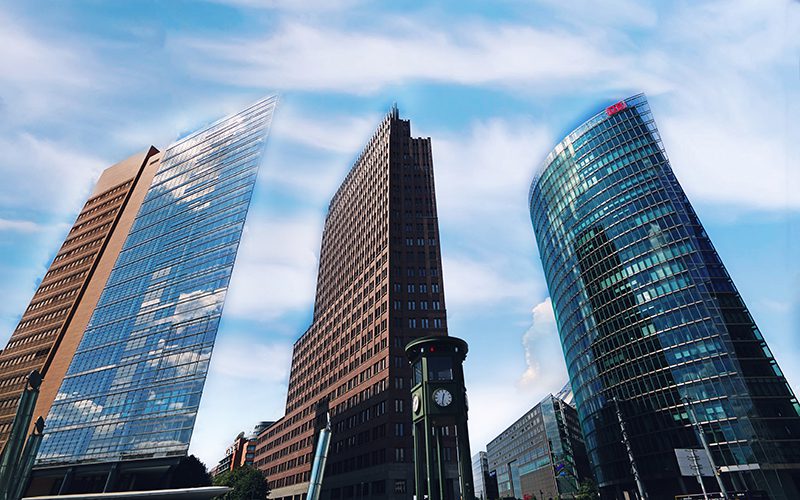
Potsdam Square (Potsdamer Platz) is Berlin’s old heart and busiest square. It is located south of the Brandenburg Gate and the Parliament Building known as the Reichstag, and southeast of Tiergarten Park. II. Until World War II, it became one of the richest places in Europe in terms of traffic, with the remote station of the same name, which had many intersecting tram and bus lines and the first light signal system.
The square, which was colored by the opening of business, entertainment and shopping centers one after the other with the demolition of the wall, shines brightly like a star, especially at night. The square, which changed completely after 1989, has turned into a center with high-rise buildings and numerous shops, stores and offices today. The most famous structure of the square is undoubtedly the Sony Center, which has become one of the landmarks of Berlin.
4. Checkpoint Charlie
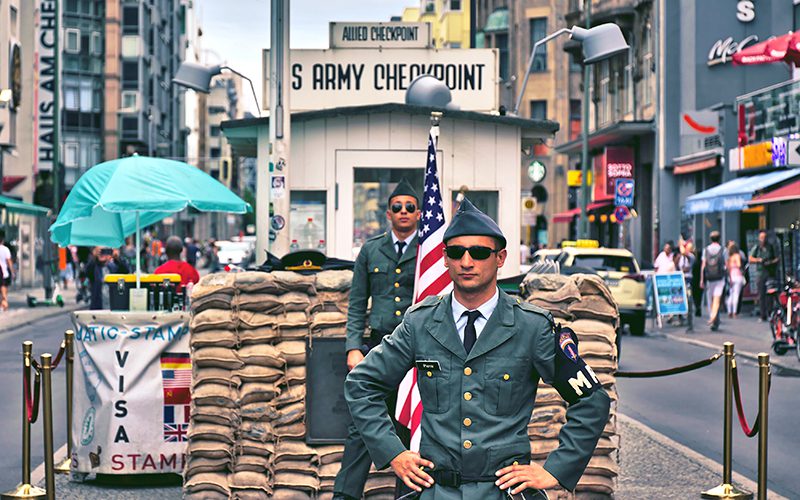
Checkpoint Charlie , the crossing point from East Berlin to West Berlin while the wall was not yet torn down , is the border crossing and control zone where American and Soviet soldiers are located. Today, it is a place where you can see the hidden parts of the Berlin Wall , which was destroyed in 1989 .
Museum Haus am Checkpoint Charlie is a place where you can witness what people go through, where you can find the sign that says ‘You are leaving the American zone’, which has not been removed, and where you can examine the barriers and signal systems that are the remains of the Cold War.
The 46-kilometer-long Berlin Wall , built by the decision of the West German Assembly in 1961, was known as the “Wall of Shame” (Schandmauer) for years between East and West Germany. Although the place of the wall, which was demolished in 1989, was turned into a park by greening it, there is still a few meters of monumental wall as a representation.
5. Gendarmenmarkt
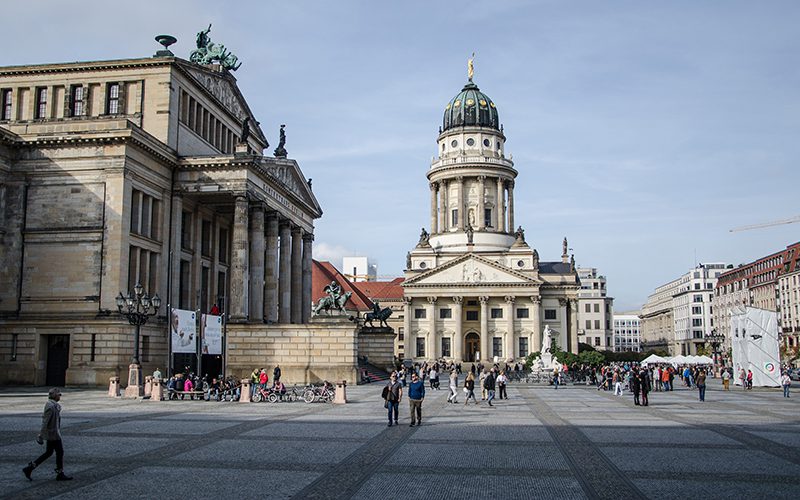
Gendarmenmarkt is located near Friedrich Street, a shopping street in the heart of the city. It is a square where music concerts are held in the open air, full of activities and cute cafes. Oranienburger Street and the Opera House in the square, which has been one of the key points of Berlin since the end of the 17th century, are the heart of Berlin’s nightlife and cultural arts.
In the middle of the square, which is home to the Französischer Dom (French Cathedral), Deutscher Dom (German Cathedral) and Konzerthaus, is the statue of architect Friedrich Schiller.
6. Berlin Cathedral
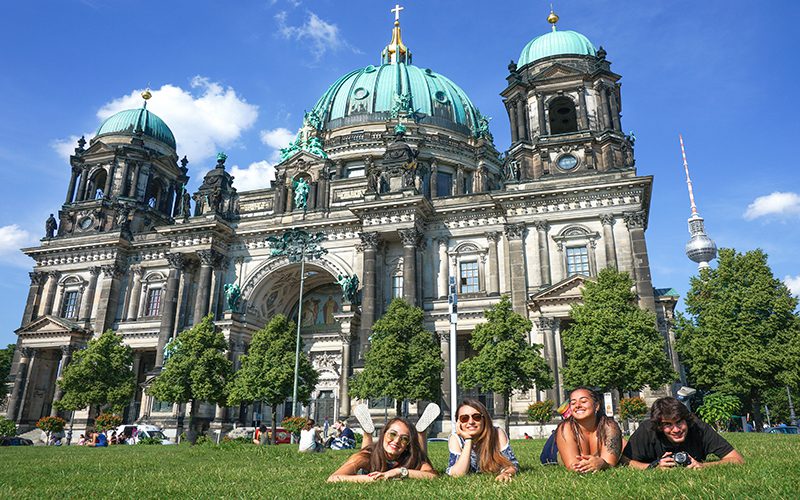
Berlin Cathedral (Berliner Dom) is a building that shines with its eye-catching dome dating back to the 15th century. Kaiser II as Berlin’s most important Protestant Church. The cathedral built by Wilhelm II. It was severely damaged in World War II. In the building, which was reopened in 1993 with renovation works, there are sarcophagi of the Hohenzollern Dynasty and Prussian kings.
Climb the 114-meter-high dome, which is reached by a 270-step staircase, to enjoy the magnificent view of Berlin. Near the cathedral, which hosts events such as concerts and exhibitions today, there is the German History Museum and Unter der Linden boulevard, which is pleasant to walk with linden trees on both sides. Museum Island and Catholic St. Hedwigs Cathedral is also nearby.
7. Museum Island
Berlin Museums can be one of the main reasons for art lovers to visit this city. There are 180 museums in Berlin, which is one of the most important cultural energy centers of Europe and inspired by different cultures. Most of the museums are located in the area called Museum Island on the Spree River. Included in the UNESCO World Heritage List in 1999, Museum Island consists of cultural forums, operas, theater and concert halls, and libraries.
The Old Museum, New Museum, Bode Museum, Pergamon Museum and Old National Gallery located on the Museum Island are the most important museums of the city. These museums display works of art that are 6,000 years old.
If you don’t have a special interest and your time in Berlin is limited, your priority should be the Pergamon Museum, the Old Museum and the New Museum, which are home to the world’s most valuable archaeological finds. When you get a Museum Card, you can visit countless Berlin museums for 3 days. The full ticket price of the Müzekart is 24€, and the student ticket is 12€.
8. Myth
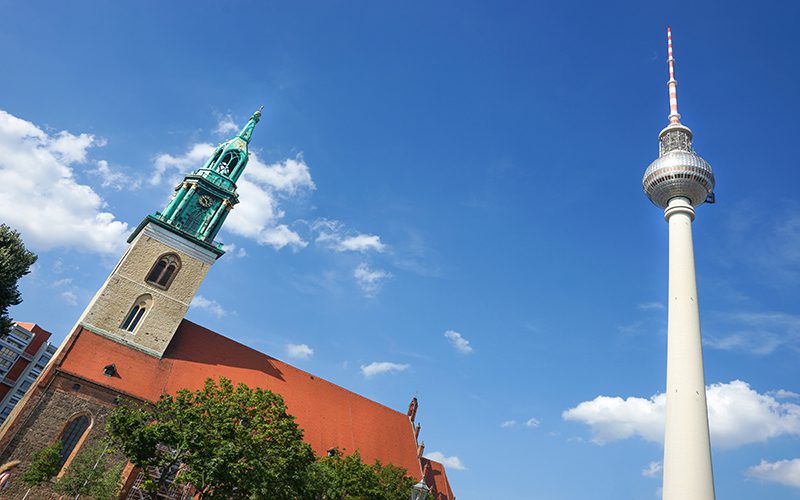
The most important tourist attraction and heart of Berlin, the Mitte district is where boutique hotels, stylish boutiques, art galleries, concept cafes and bars, restaurants and Berlin nightlife and entertainment venues are located. The Berlin Television Tower, a 368-metre tall structure popularly known as the Fersenhturm and seen from quite a distance, is Berlin’s tallest building . The tower, which is the tallest building in the city, is visited by approximately 1 million people a year.
You get 25% discount when you visit the tower, which was built in the 1960s and offers 360-degree panoramic views of the city, with the Berlin WelcomeCard. The Berlin WelcomeCard also allows you to use all public transport services free of charge and to get discounts on your shopping with over two hundred partners.
9. Alexanderplatz
Alexanderplatz (Alexander Square), one of the most important squares in Berlin and located to the east of the Brandenburg Gate and the Reichstag , is a square that still bears the traces of the socialist era. A square that Berliners call Alex. After the collapse of the Berlin Wall, Alexanderplatz, which has a very aesthetic and touristic appearance with its buildings that underwent many restoration processes, also shows itself in many changes in terms of transportation.
10. Tiergarten
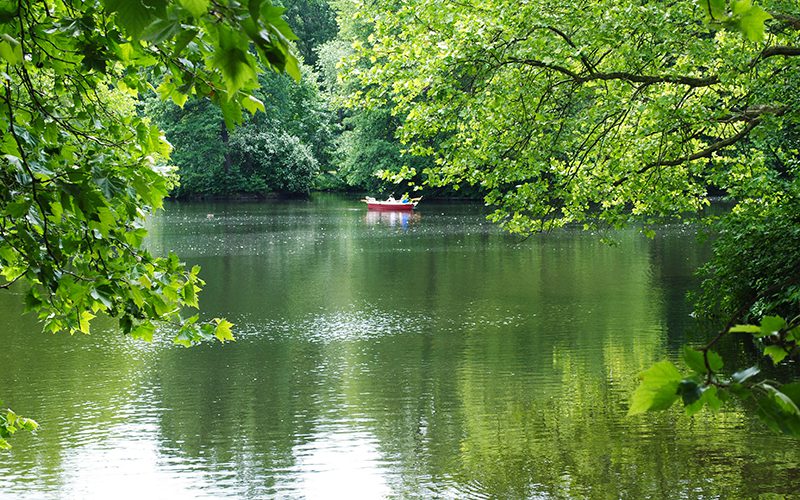
Tiergarten , which we can call almost the liveliest area of Berlin , is located in Mitte, the central district. The area, which is famous for the Tiergarten Park (Großer Tiergarten), has many public buildings, the prime minister’s residence, the Victory Column (Siegessäule), the Bismarck Monument and the statues of the Prussian generals. Tiergarten Park, on the other hand, is Berlin’s largest city park with an area of 210 hectares.
Right next to it, there is the Contemporary Fine Arts and the German Historical Museum for its enthusiasts.
Zoologsche Garten is Berlin’s oldest zoo, located southeast of the Tiergarten. For little Berlin visitors, this place can be exciting. It is home to 14 thousand animals consisting of 1500 species.
11. Charlottenburg Palace
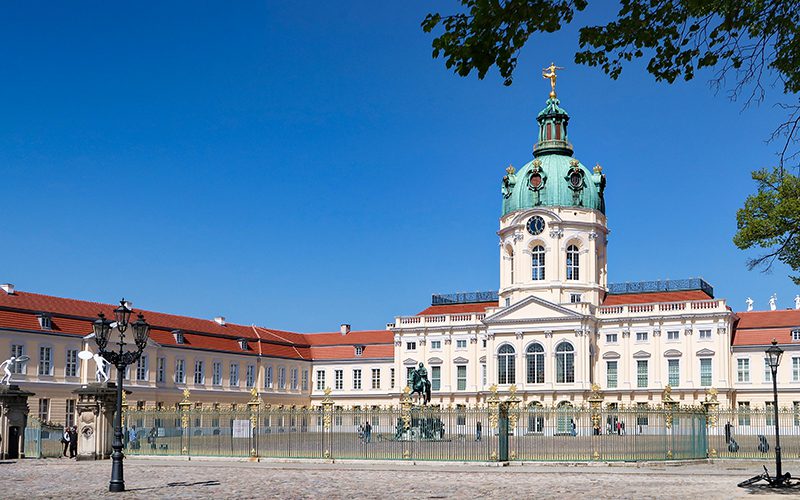
Schloss Charlottenburg (Charlottenburg Palace) is a 17th-century palace located in the Charlottenburg District, west of the Tiergarten. The palace, which is the only legacy of the Hohenzollern Dynasty in Berlin, carries baroque and rococo styles. It is also quite beautiful with its park by the Spree River surrounding the palace.
Charlottenburg Palace, one of the most spectacular palaces in the city, consists of a mansion, theatre, mausoleum, greenhouse and garden. Belvedere and Schinkel Mansion, Romance Gallery, Berggruen Collection and Egyptian Museum should be seen. Queen Luise Monument is also among the places to see.
12. Sachsenhausen
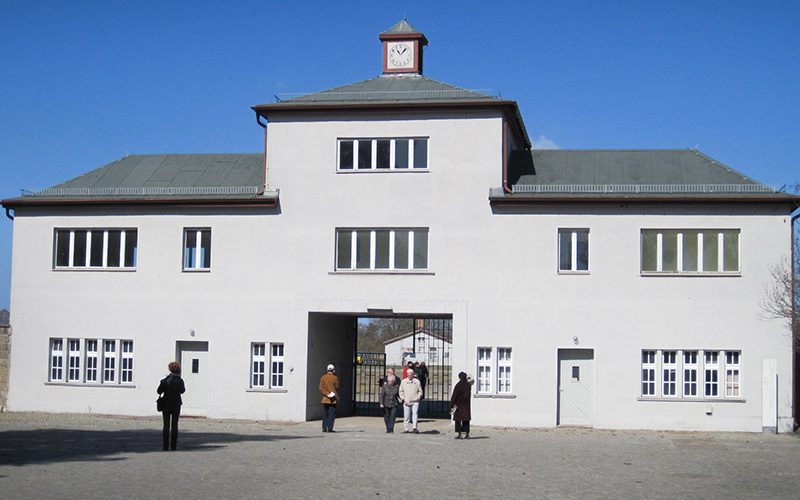
Located 35 kilometers from Berlin, Sachsenhausen was used as the administrative center of the Nazi concentration camps and the training center for SS officers. In the camp, which was established in 1936 and where more than 200,000 people were held captive until 1945, there is a pathology laboratory where various surgeries are performed, as well as the gas chamber in the “Industie Zentrum” section, which is still closed to visitors.
Berlin culture and entertainment
Berlin is also internationally known as Europe’s cultural capital in the fields of architecture, fine arts and performing arts. With the reunification of the city in 1990, the young population under the age of 35 took action to increase the cultural richness of the city. Therefore, there are many theaters and cinemas in the city.
In Berlin, where artistic and architectural lines complement each other, the oldest Berlin Gallery Stage is located around Savignyplatz. The area around Auguststraße and Tiergarten Potsdamer Platz is the heart of the Berlin gallery centre.
East Side Gallery of the Berlin Wall painted by many artists; The magnificent Charlottenburg Palace, one of the most vivid examples of Baroque art, and Potsdam, which has the most magnificent examples of Prussian art; Standing out as Germany’s first Neo-Classical building, the Bellevue Palace and the Contemporary Art Museum, Maxim Gorki, Deutsches, Berliner Ensemble Theaters and Deutsche and Komische Operas are among the city’s most important cultural and artistic centers.
Hamburg Train Station leading the contemporary art route, the Berlin Gallery dedicated to modern and contemporary art in Berlin, and the Picture Gallery at the Cultural Forum exhibit its European painting collection, which includes masterpieces from all eras with worldwide meaning.
Nearby is Mies van der Rohe’s New National Gallery, a glass work featuring magnificent special exhibitions and a valuable collection of modern art. The Scharf Gesternberg Collection, which includes surreal works of art; At the Bröhan Museum, which gives an authentic impression of New Style, Art Déco and Functionalism, the Berggrün Museum exhibits works of art by Pablo Picasso, Paul Klee and Henri Matisse.
Berlin also hosts many international festivals. Among the most important of these are the Berlin Theater Gathering, Literature Festival, Jazz Festival and Biennale. Known as the Berlinale International Film Festival, the event is the world’s largest audience festival.
Three operas, more than 50 theatres, 180 museums and collections, as well as commercial galleries of approximately 600; With 130 cinemas and countless other facilities, Berlin is an international cultural metropolis.
In addition to Berlin Art Week, which brings together many fairs, art and cultural institutes, Gallery Weekend also brings together nearly a hundred participants in the biggest art event in Berlin. The Berlin Academy of Art, one of the most popular art venues in Berlin with its regular exhibitions; contemporary art fair that brings together artists and galleries.
Famous for being an exhibition space that fascinates thousands of visitors every year, the Berlin Art Forum is among the special venues famous for its events.
Berlin shopping
Berlin has many shopping streets, but Kurfürstendamm (known as Ku’damm for short) is the city’s most important shopping street.
Kurfürstendamm is Berlin’s favorite shopping destination with luxury brands and department store chains. It is located in KaDeWe, Europe’s largest shopping mall, on Tauentzien Street in its extension.
It is possible to find all kinds of brands and the best hotels in the city here. Another shopping street of the center is Friedrichstraße, which is home to many shops. For those who love young and independent fashion, the best shops are also located in Berlin.
In Mitte, you can find the trendiest boutiques, especially on Neue Schönhauser and Hackesche Höfe streets. Also worth seeing is the Farmer’s Market at Wittenbergplatz. If you come in December, don’t forget to do your Christmas shopping, they can offer unmissable discounts.
Berlin eating and drinking
In Berlin, you can find many examples of international cuisine. It has a cuisine for every taste. It appeals to your taste buds with very different flavors from the traditional cuisines of French, German, Indian, Indonesian, Italian, Taiwanese, Turkish, Arabian and many other countries.
You can have breakfast until 4 noon in Berlin. The cafes in the city (both the old-style ones to the west and the new ones to the east) offer quite a few light treats, and an afternoon coffee and cake is a pretty good selection. Although Germany is not very famous for its cuisine, it is kind of a tradition to eat dessert in Berlin. Among the reasons for the lack of development of the kitchen is that the culture of eating out has developed due to the presence of too many ethnic restaurants.
Beef and vegetables are important components of traditional urban cuisine. Potato salad, fried or raw mince bread and black pudding are among the famous dishes of the city. As a natural consequence of being home to many breweries, Berlin has a myriad of beers.
In Berlin, you will find many restaurants with a poetic atmosphere, serving a variety of delicacies, breakfasts and excellent Berlin pizza.
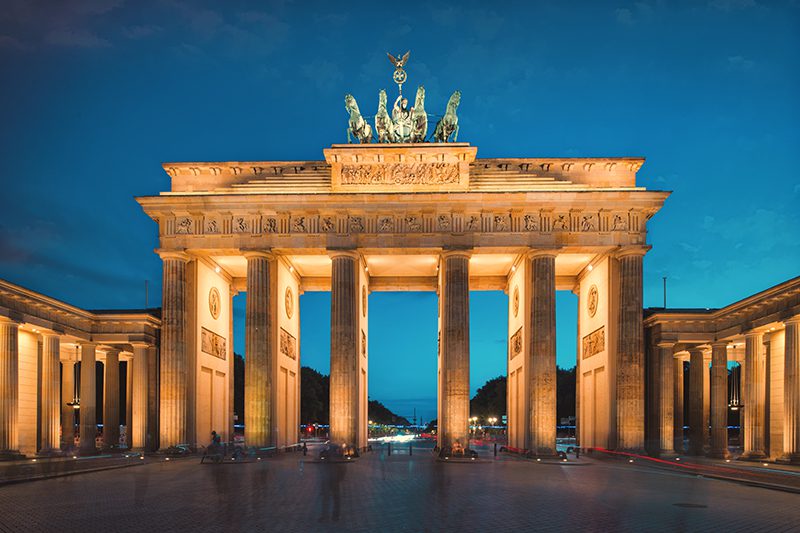
How to get to Berlin
If you are coming from within Germany or Western Europe, most planes land at Tegel Airport. The Mitte area in the city center can be reached using JetExpressBus in a 2-hour journey. If you are staying on the Charlottenburg or Wilmersdorf side, take the X9 or 109 buses.
➤ Tegel Airport ; Tegel Airport, located 8 km from the city center in the northwest of Berlin, is like a bridge connecting the city to Western Europe. It consists of 5 terminals, Terminal A, B, C, D and E. Most international flights depart from Terminal A. It is located at a very easily accessible point.
➤ Schönefeld Airport ; The airport where low-cost airlines such as EasyJet, Ryanair and Germanwings fly. Flights to Eastern Europe are mainly made from here. It is located southeast of Berlin and 19 km away. Flights are made from 4 terminals, namely Terminals A, B, C and D.
If you are coming from Eastern Europe, Asia or Africa, you will land at Schönefeld Airport. The AirportExpress train can take you to the city centre, the Bahnhof Zoo, Alexanderplatz and Ostbahof.
By bus; To reach the city center from Tegel, you can take one of the lines X9, 109 and TXL, and from Schönefeld you can take the X7. After getting off the bus, you can reach many points of the city by using the U-Bahn and S-Bahn metro lines.
With subway; There is no metro line from Tegel to the city centre. However, it is possible to reach many central points by using the S9 or S45 lines of the S-Bahn from Schönefeld.













